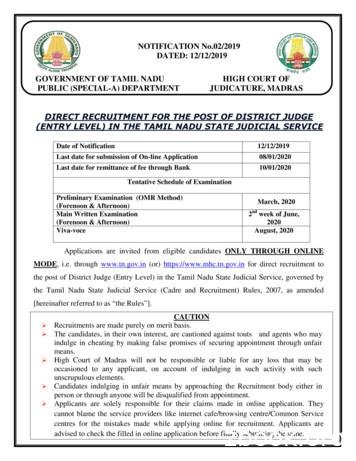Sense Of Belonging Presentation
Sense of Belonging in MathNote. These materials were produced for the WA STEM partnershipcoaching meeting on 2/21/18, 2/22/18, and 2/23/18.
Icebreaker123Form a group of three with peopleyou don’t know well.Spend 5 minutes finding the threemost interesting things that allmembers of your group have incommon.Introduce yourself to the large groupand tell everyone your three things incommon.
Learning ObjectivesBy the end of this session, you will be able to: Define sense of belonging Explain the importance of belonging foracademic success in math Apply actionable strategies to promotebelonging in math classrooms
Belonging: What Is It?Feeling like an accepted, valued, and legitimate group member.Baumeister & Leary (1995)
Belonging Is a Fundamental NeedThe need for social connections is innate and universal.It is a need, not a want.Vs.Baumeister & Leary (1995)
Exclusion Is PainfulPsychological consequences Sadness, anger Decreased self-esteem Impaired self-regulation Poorer cognitive functionPhysical consequences Brain science suggests social pain and physicalpain are experienced in overlapping brain systems Loneliness poses the same health risks assmoking, drinking, and obesityBaumeister & Leary (1995)
Belonging and IdentityBelonging
Belonging and IdentityBelonging Perceived fit within a group or domainIdentity Importance placed on being a member of a group or domainBelongingIdentity
Belonging Brainstorm Think about a time when youexperienced a sense of belonging in agroup. How did you know youbelonged? Think about a time when you didn’texperience belonging in a group.What happened? Think about a time you witnessedsomeone else struggle with belonging.What happened?
Students Seek Belonging The lives of children and youth aresocially complex. They are constantlymonitoring their belonging status. Sense of belonging particularly acute for: Early adolescents Children transitioning betweenschools and grades Children with marginalized identities
Belonging in School: So sSchool BelongingDecreased: Substance use Early sexualinitiationGoodenow (1993);Osterman (2000) ViolenceSuicidal ideationDisordered eatingIncreased: Self-efficacy Motivation Attendance Persistence Achievement
Students’ Mindsets Influence Behaviors andAchievementAcademicMindsetAdapted from Farrington (2013)AcademicBehaviorsAcademicOutcomes
Growth Mindset Is an Academic MindsetFarrington’s Four KeyAcademic Mindsets:1. I belong in this community2. I can succeed at this3. My ability and my competencegrow with my effort4. This work has value for meThis Is Sense of BelongingAdapted from Farrington (2013)
Belonging as a“Psychological erest
Lack of Belonging Saps Concentration and FocusDo I belong here?I’m not sure More vigilantClassmatedidn’t say“hi” in hallAssume theworstTeacherdidn’t callon meWalton & Cohen (2007)Bad gradeon mathquiz
Do I Fit in Socially?I’m not sure Ibelong No one atthis schoollikes me.Less efforttowardrelationships.Walton & Cohen (2007)Classmatedidn’t say “hi”in hallInterpretationResponseYes,I belong!It was loudin thehallway.Be more directnext time.
Belonging and EquityAddressing achievement gaps and otherinequitable life outcomesStructuralInequality andDiscriminationAchievementGapsLower Sense ofBelonging“In the meantime”
Belonging Is MultidimensionalDo Ibelonghere?Lewis & Hodges (2015)
Do I Fit in Intellectually?I’m not sure Ibelong I’m not cutout formath.Avoid mathBad grade on amath quizInterpretationResponseYes,I belong!I need tostudy moreAsk teacher forstudy tips
Who Belongs in Math?First five images from Google Image search for “math genius.”
Math Stereotypes Stereotypes about race and gender can actas barriers that prevent girls and studentsof color from developing interests in STEM. “Stereotype threat” is when someoneunderperforms because of a negativestereotype about how they should perform. Math anxiety and stereotype threat likelyshare a common mechanism: workingmemory. Both math anxiety and stereotype threatstart early. Children can form automaticassociations that affect performance beforethey even consciously endorsestereotypes.Master & Meltzoff (2017); Galdi, Cadinu, & Tomasetto (2014)
Girls and Math“Boys do not pursue mathematical activitiesat a higher rate than girls do because theyare better at math. They do so, at leastpartially, because they think they are better.”—Shelley Correll,Stanford Sociologist
What’s Inside a Stereotype?Example: gender stereotypeMay represent multiple, intertwined stereotypes (e.g., cultural fit and ability)CulturalStereotypesSTEM maleAbilityStereotypesGendergaps inSTEMGirls haveless abilitythan boysFigure adapted from Cheryan, Master, & Meltzoff (2015)Counteracting stereotypes can increase interest in STEM among girls andstudents of color by increasing their confidence and making them feel like theybelong in math.
BREAK
General Classroom Strategies toPromote Belonging Create a welcoming, inclusive classroom culture.o Work on eye contact, using students’ names, and pronouncing namescorrectly.oBe sure the classroom environment doesn’t inadvertently signal that onlysome students belong. Build relationshipso Teacher-studento Student-peerso Teacher-familyCheryan, Plaut, Davies, & Steele (2009); Miller et al. (2017); https://www.mindsetkit.org
Strategies to PromoteBelonging in MathNormalizing UncertaintyGroup Membership
Normalizing Uncertainty: It’s OK to StruggleAnyone can be anengineer or a scientist but can I?Well, I guess evenEINSTEIN struggledwith math!Lin-Siegler, Ahn, Chen, Fang, & Luna-Lucero (2016)
How “Struggle Stories” WorkUncertaintyabout belongingMore vigilantClassmatedidn’t say“hi” in d gradeon mathquiz
Normalizing Uncertainty InterventionHelp students frame setbacks and anxieties aboutbelonging as common and transitory instead ofproof that they don’t belong.I’ve been there, too.It gets better.
Normalizing Uncertainty InterventionReflective reading and writing exercise:Part 1: Students hear first-person stories from moreadvanced students that convey that it’s typical toworry about belonging and normal to struggle inschool (regardless of race, gender, or otherbackground characteristics), and that over timethese concerns fade.Authenticity is important!
Normalizing Uncertainty InterventionReflective reading and writing exercise:Part 2: Saying-is-believing: Writing exercisesgive students the opportunity to internalize themessage.
Strategies to Promote Belonging in MathNormalizing UncertaintyGroup Membership
Group MembershipWe are themultiplicationgroup!Master & Meltzoff (2016)
Group Membership“You’re part ofthe sun group!”Master & Meltzoff (2017)“The blue groupdoes puzzles”Individual condition
Make Math Collaborative:The Jigsaw ClassroomMethod of organizing classroom lessons in a way thatfosters relationships. Group members depend on eachother and must interact to complete the lesson.Walker & Crogan (1998)
How-To: Jigsaw Classroom1.2.3.Divide students into “expert” groups. Each expert group learnsextensively about one component of the lesson.Next, students regroup into “home” groups. Each home groupincludes one expert on each different component of the lesson.Each expert is in charge of explaining his or her expert topic tothe rest of the home group.MeanMeanMedianMeanMedianModeModeMeanWalker & Crogan (1998)MedianMedianModeMode
A Note of Caution Because children are sensitive to socialcues, group membership must be usedcarefully Associating groups with activities mayincrease motivation, but associatinggroups with an underlying or fixed ability atthose activities may decrease motivation Take care to express that you value eachgroup’s contributions equally
Small-GroupActivity:Teacher GuidesReviewTake each of the two handoutsprovided and discuss among yourtable group:What do you like about theintervention?What might you have to adapt to makeit useful?What questions do you have about theintervention?
ReflectionWhat stood out for you,increased your knowledge, orchanged your thinking duringthis session?What is one thing you learned ordiscussed today that you willtake back and apply to yourwork with teachers and/or yourclassroom?
ReferencesBaumeister, R. F., & Leary, M. R. (1995). The need to belong: desire for interpersonal attachments as a fundamental humanmotivation. Psychological Bulletin, 117(3), 497-529.Cheryan, S., Plaut, V. C., Davies, P. G., & Steele, C. M. (2009). Ambient belonging: how stereotypical cues impact genderparticipation in computer science. Journal of Personality and Social Psychology, 97, 1045-1060.Galdi, S., Cadinu, M., & Tomasetto, C. (2014). The roots of stereotype threat: when automatic associations disrupt girls' mathperformance. Child Development, 85(1), 250-263.Goodenow, C. (1993). Classroom belonging among early adolescent students: Relationships to motivation and achievement. TheJournal of Early Adolescence, 13(1), 21-43.Lewis, K. L., & Hodges, S. D. (2015). Expanding the concept of belonging in academic domains: Development and validation of theAbility Uncertainty Scale. Learning and Individual Differences, 37, 197-202.Lin-Siegler, X., Ahn, J. N., Chen, J., Fang, F. F. A., & Luna-Lucero, M. (2016). Even Einstein struggled: Effects of learning aboutgreat scientists’ struggles on high school students’ motivation to learn science. Journal of Educational Psychology, 108(3), 314.Master, A., & Meltzoff, A. N. (2016). Building bridges between psychological science and education: Cultural stereotypes, STEM, andequity. Prospects, 46(2), 215-234.Miller, C. F., Kochel, K. P., Wheeler, L. A., Updegraff, K. A., Fabes, R. A., Martin, C. L., & Hanish, L. D. (2017). The efficacy of arelationship building intervention in 5th grade. Journal of School Psychology, 61, 75-88.Osterman, K. F. (2000). Students’ need for belonging in the school community. Review of Educational Research, 70(3), 323–367.Walker, I., & Crogan, M. (1998). Academic performance, prejudice, and the jigsaw classroom: New pieces to the puzzle. Journal ofCommunity & Applied Social Psychology, 8(6), 381-393.
About REL NorthwestRELs partner with practitioners andpolicymakers to use data andevidence to help solve educationalproblems that impede studentsuccess. We do this by: Conducting rigorous research anddata analysis Delivering customized training,coaching, and technical support Providing engaging learningopportunities
Contact Uswww.educationnorthwest.orgEducation Northwest@educationnorthwest101 SW Main Street Suite 500Portland, OR 97204-3213@educationnw1.800.547.6339
Goodenow, C. (1993). Classroom belonging among early adolescent students: Relationships to motivation and achievement. The Journal of Early Adolescence, 13 (1), 21-43. Lewis, K. L., & Hodges, S. D. (2015). Expanding the concept of belonging in academic domains: Development and validation of t he Ability Uncertainty Scale.
practices, remember that culture is continually changing and shifting over time. Diversity, Inclusion, and Belonging shouldn't be about filling a quota. It is a true sense of belonging among your team, which is likely filled with people from all backgrounds. creating a sense of belonging can lead to greater retention rates and even result in higher
St. Lawrence College Belonging EDI Task Force Recommendations Report 2020-2021 3 A NOTE TO READERS EKTA SINGH Senior Advisor, Belonging and EDI This document is not a report. Of course, it contains a detailed account of the work of St. Lawrence College's Belonging and EDI Task Force, a rich set of data that informs the vision we are
Sense-of-urgency is the first core concept in this study. Several definitions exist on the concept of sense-of-urgency. For instance, sense-of-urgency is defined as employee’s determination to change [5]. Other scholars peg sense-of-urgency as a crucial element in successful change process [6]. On the other hand, some scholars define sense-of .
Creating safe and supportive learning environments and developing a sense of belonging have been shown to improve resilience (Lee et al., 2013; Pidgeon et al., 2014). A sense of satisfaction of belonging within an educational environment is significantly associated with students' engagement, academic success and improves their social and
Journal of the Scholarship of Teaching and Learning, Vol. 19, No. 1, February 2019, pp. 117-127. doi: 10.14434/josotl.v19i1.26787. Students' Sense of Belonging:
Page 4 of 11 Explanation- (i) Applicants should not have been born after 01.07.1984 and should not have been born before: (a) 02.07.1971 (in case of reserved category applicants viz. SC / ST / SC(A) belonging to the State of Tamil Nadu) (b) 02.07.1974 (in case of ‘Others’ & applicants from other States / Union Territories) (ii) The Persons belonging to the State of Tamil Nadu and belonging .
Chapter 20 – Belonging 1 Coordinating Lead Authors:[1] Akeel Bilgrami, Prabhat Patnaik 2 Lead Authors:[2] Faisal Devji, Michele Lamont, Aihwa Ong, Ernesto Ottone, Sonja Puntscher-Riekmann, James Tully, Nira Wickramasinghe, Sue Wright 3 Word count: 30,349 4 Belonging is a relation that a
Operation Guide for the Mercedes-Benz GLA/CLA This is a basic operation guide for those who are driving the Mercedes-Benz GLA/CLA vehicle for the first time. Please read this guide before you leave the rental office if you are not familiar with operation. For more information about the vehicle, please read the instruction manual. Basic Operations to Note Before Driving the Vehicle Starting .























